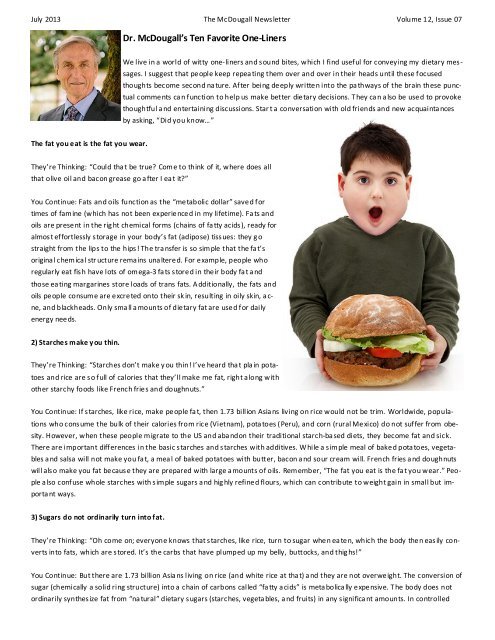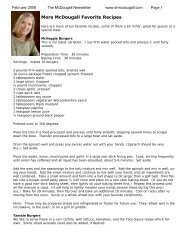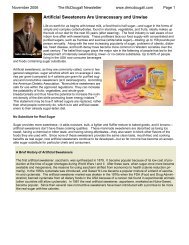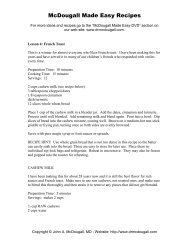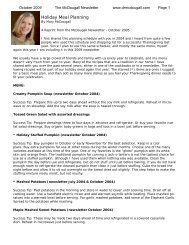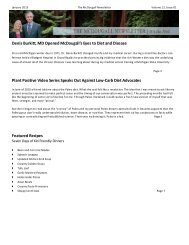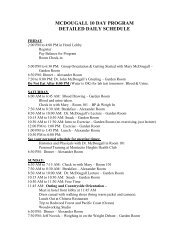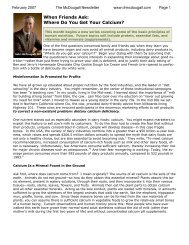July 2013 The <strong>McDougall</strong> Newsletter Volume 12, Issue 07<strong>Dr</strong>. <strong>McDougall</strong>’s Ten Favorite One-LinersWe live in a world of witty one-liners and sound bites, which I find useful for conveying my dietary messages.I suggest that people keep repea ting them over and over in their heads until these focusedthoughts become second na ture. After being deeply written into the pa thways of the brain these punctualcomments ca n function to help us make better dietary decisions. T hey ca n a lso be used to provokethoughtful a nd entertaining discussions. Star t a conversation with old friends and new acquainta ncesby asking, “Did you know…”The fat you eat is the fat you wear.They’re Thinking: “Could tha t be true? Come to think of it, where does allthat olive oil and bacon grease go a fter I ea t it?”You Continue: Fats and oils function as the “metabolic dollar” saved fortimes of famine (which has not been experienced in my lifetime). Fa ts andoils are present in the rig ht chemical forms (chains of fa tty acids), ready foralmost effortlessly storage in your body’s fat (adipose) tissues: they g ostraight from the lips to the hips! The tra nsfer is so simple that the fa t’sorigina l chemica l str ucture rema ins una ltered. For example, people whoregularly eat fish have lots of omega-3 fa ts stored in their body fa t a ndthose ea ting margarines store loads of trans fats. A dditionally, the fats andoils people consume are excreted onto their sk in, resulting in oily skin, a c-ne, and blackheads. Only sma ll a mounts of dietary fat are used for dailyenergy needs.2) Starches make y ou thin.They’re Thinking: “Starches don’t make y ou thin! I’ve heard tha t pla in potatoesand rice are so full of calories that they’ll make me fat, right a long withother starchy foods like French fries and doughnuts.”You Continue: If starches, like rice, make people fa t, then 1.73 billion Asia ns living on rice would not be trim. Worldwide, populationswho consume the bulk of their calories from rice (Vietnam), pota toes (Peru), and corn (rural Mexico) do not suffer from obesity.However, when these people migrate to the US and aba ndon their traditional starch-ba sed diets, they become fat and sick.There are important differences in the basic starches and starches with additives. While a simple meal of baked pota toes, vegetablesa nd salsa will not make you fa t, a mea l of baked potatoes with butter, bacon a nd sour cream will. French fries a nd doughnutswill also make you fat because they are prepared with large a mounts of oils. Remember, “The fat you eat is the fa t you wear.” Peoplea lso confuse whole starches with simple sugars a nd hig hly refined flours, which can contribute to weight gain in small but important ways.3) Sugars do not ordinarily turn into fat.They’re Thinking: “Oh come on; everyone knows that starches, like rice, turn to sugar when ea ten, which the body then easily convertsinto fats, which are stored. It’s the carbs that have plumped up my belly, buttocks, and thig hs!”You Continue: But there are 1.73 billion Asia ns living on rice (and white rice at tha t) a nd they are not overweight. The conversion ofsugar (chemically a solid ring structure) into a chain of carbons called “fa tty a cids” is meta bolica lly expensive. T he body does notordinarily synthesize fat from “na tural” dietary sugars (starches, vegeta bles, a nd fruits) in any significa nt amounts. In controlled
July 2013 The <strong>McDougall</strong> Newsletter Volume 12, Issue 07experiments, however, when people are pur posefully overfed simple sugars (white sugar, etc.) a nd refined flours they will thenmake only a small amount of body fa t. From excess body fat comes type-2 dia betes. T his common disease is easily cured afterswitching the kind of calories consumed from fats (mea t, cheese, vegeta ble oil) to sugars (starches, vegeta bles, a nd fruits); andwith the drama tic weight loss tha t follows.4) Sugar satisfies the hunger driv e.They’re Thinking: “The only thing tha t fills me up is mea t. If I eat a Chinese dinner with mostly rice and noodles, I a m hungry a nhour later; I need my meat and cheese to be sa tisfied.”You Continue: When people first switch to a starch-based diet they will initially miss the chunks of meat a nd globs of fat occupyingtheir stomachs. They may inter pret this change in physica l sensation as hunger. But true long-lasting sa tisfa ction of hung er (sa tiety)is triggered in the brain by rises in blood sugar from eating plant sugars. The hunger drive responds to sugar (carbohydra te) lik e thebreathing drive does to oxygen and the thirst drive does to wa ter. Fat provides almost no sa tiety, which contributes to their almostlimitless consumption by people. Simple sugars (glucose, fructose, fruit, juice, etc.) pr ovide only short-lived satiety. Complex sugars(starches and vegetables) keep you feeling full for hours between mea ls. Since, the typical American diet is low on the longduration,a ppetite-sa tisfying sugars, people are left still hungry after eating meat, cheese, and vegeta ble oil (conta ining no car bohydrates).T his disconnection between eating a nd satiety leads them to believe that there is something emotionally wrong with them;maybe they are obsessive-compulsive overeaters. Starches immedia tely bring about feelings of wellbeing, control, a nd sa fety.5) Pr otein deficiency is impossible, even on a vegan diet.They’re Thinking: “Meat a nd eggs are my protein sources. S tarches, vegetables, and fruits have too little pr otein, plus these areincomplete proteins, missing essential amino acids.”You Continue: We know tha t meat a nd eggs are full of sa turated fa ts a nd cholesterol, which, at the very least, ca use heart a ttacksand strokes; so why would Na ture design huma n nutrition requirements so that we must risk our life in or der to obta in essentialnutrients (including protein)? S he doesn’t. Plants have sufficient protein to grow giraffes, elephants, and cows, so obv iously theyhave enoug h to grow rela tively small people. A ll twenty amino acids, including the 10 essential ones, needed for good health areabundant in pla nts. In real life there is no such thing as protein deficiency, yet the mea t a nd dairy industries generate tons of profitwith these universally accepted lies.6) There is no such thing as dietary calcium deficiency.They’re Thinking: “But without milk my bones would weaken and I would break a hip. Milk is the best source of ca lcium, a nd plantsare calcium deficient.”You Continue: Women in Asia a nd A frica grow normal adult skeletons without consuming a ny milk after they wean from theirmother’s breast. Rural Africa n women consume 400 mg of ca lcium da ily, often have 10 babies, and nurse them for 10 months, yetdo not have hip fractures (and 10% live to be older tha n 60). T hey also ea t a diet of starches (corn a nd rice) with few a nima l foods.(Calcium recommenda tions are as high as 2000 mg/day for US women). Our calcium requirements are so sma ll tha t there has neverbeen a case of “dietary ca lcium deficiency ” ever reported on a ny na tural diet, even diets with no dairy foods at all. Osteoporosisis not due to calcium deficiency, but primarily due to an a cidic condition created in the body from consuming meats and cheeses.The only reason you believe otherwise a bout protein and calcium is because of the size of the mega phones the meat and da iryindustries hold.7) Plants, not fish, make all omega-3 (good) fats.They’re Thinking: “Fish have a unique meta bolism that allows them to make essentia l omega-3 fats. These fats act like powerful


